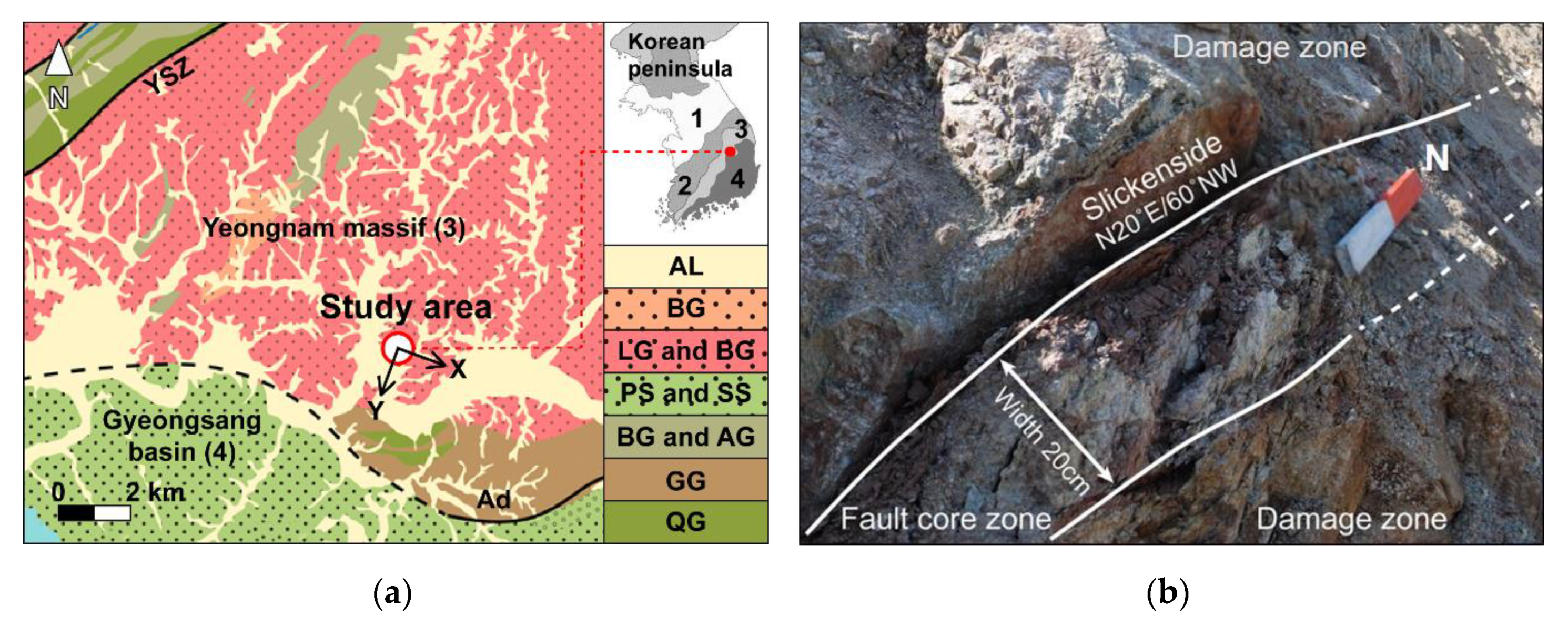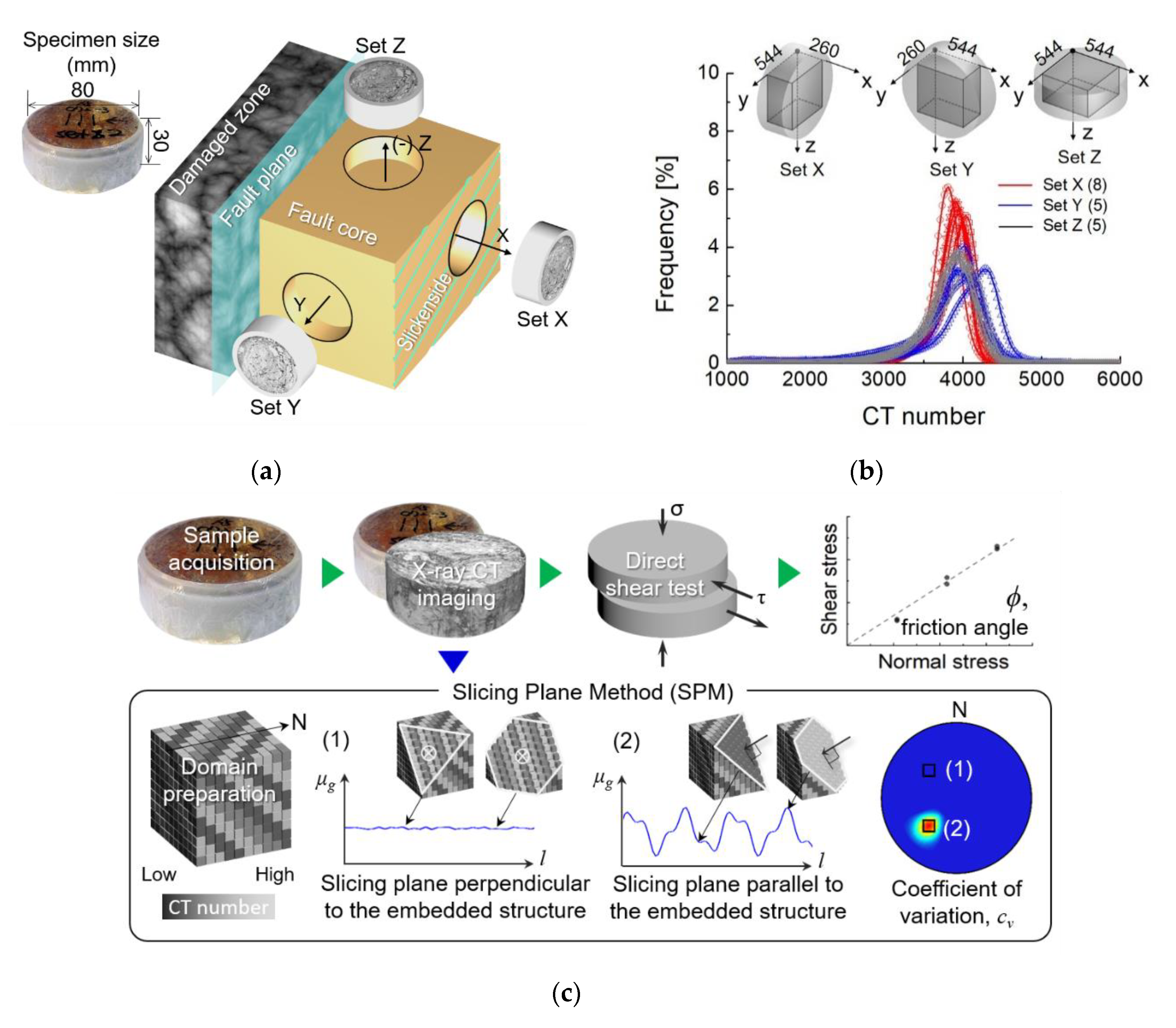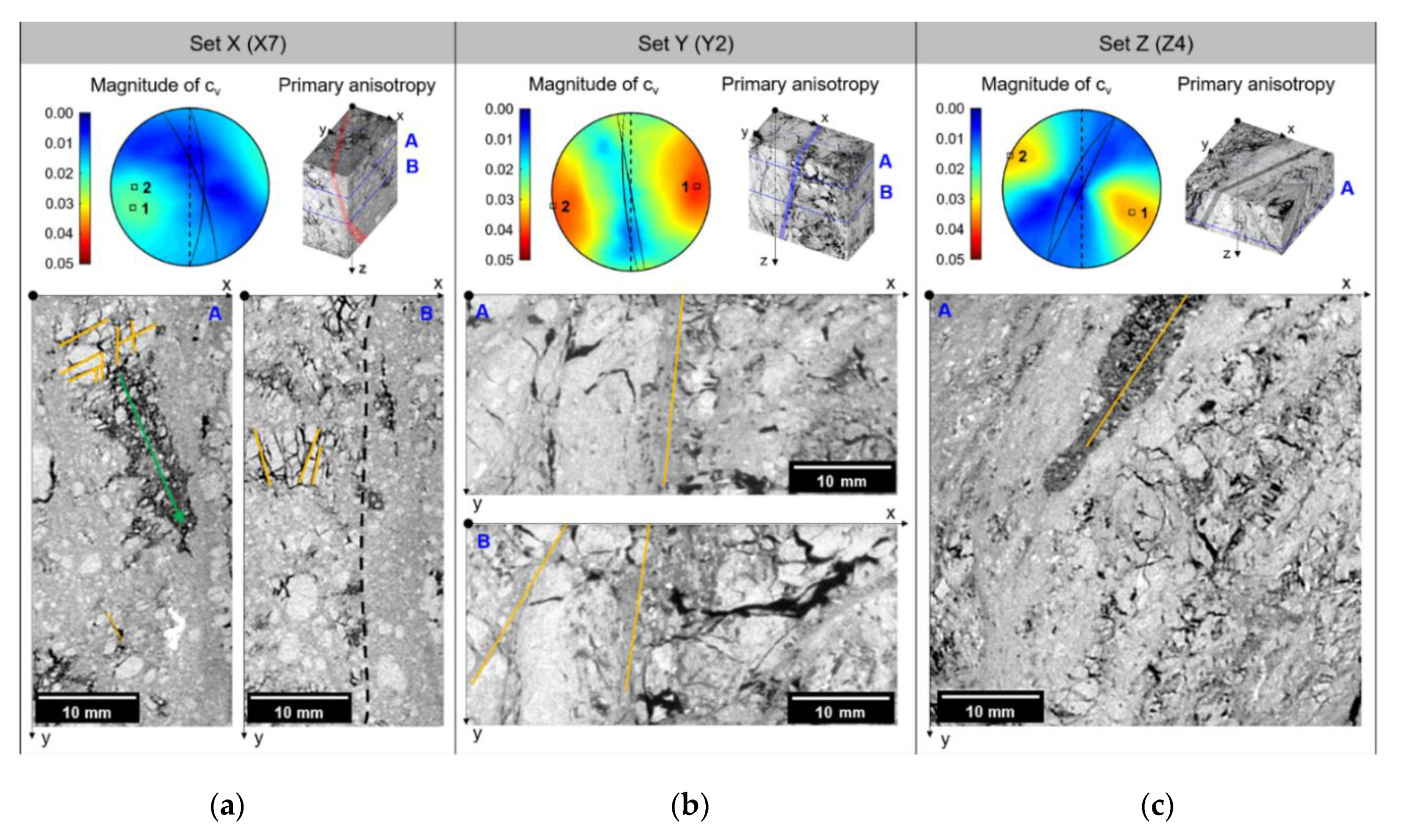Estimation of the Structural and Geomechanical Anisotropy in Fault Gouges Using 3D Micro-Computed Tomography (μ-CT)
Abstract
1. Introduction
2. Materials and Methods
2.1. Fault Gouge Specimens
2.2. μ-CT Image-Based Analysis
2.3. Direct Shear Test
3. Results and Discussion
3.1. Anisotropy in Fault Gouges (μ-CT Imaging)
3.2. Anisotropy of Constituents
3.3. Correlation between Friction Angle and Anisotropy
4. Discussion
5. Conclusions
- The undisturbed specimens were cored along three orthogonal directions, and were subjected to X-ray CT scanning followed by SPM. The results show that despite the varied coring directions, the SPM provides consistent evaluations of the 3D structural anisotropy of the fault gouges. It was confirmed that the core-scale orientation of the structural anisotropy is almost parallel to the fault plane, and the main contributor to the anisotropy is the layered structure of the matrix with solid particles in natural fault gouges.
- After the X-ray CT scanning, direct shear tests were conducted under different shearing directions and shear planes. The frictional coefficient is lowest when the shearing occurs on the shear plane parallel to the fault plane, and the frictional coefficient doubles when the shear plane is perpendicular to the fault plane.
- The results show that the structural anisotropy identified by SPM and the anisotropy of frictional resistance of fault gouges are correlated to the orientation of fault plane. This suggests that the evaluation of structural anisotropy by SPM indicates the weakening direction of the frictional resistance of fault gouges.
Author Contributions
Funding
Acknowledgments
Conflicts of Interest
References
- Sausgruber, T.; Brandner, R. The relevance of brittle fault zones in tunnel construction—Lower Inn Valley feeder line north of the Brenner Base Tunnel, Tyrol, Austria. Mitt. Osterr. Geol. Ges. 2003, 94, 157–172. [Google Scholar]
- Goricki, A.; Rachaniotis, N.; Hoek, E.; Marinos, P.; Tsotsos, S.; Schubert, W. Support Decision Criteria for Tunnels in Fault Zones. In Proceedings of the 55th Geomechanics Colloquium, Salsburg, Austria, 11–13 October 2006; Volume 24, pp. 51–57. [Google Scholar]
- Angelier, J. Tectonic analysis of fault slip data sets. J. Geophys. Res. Solid Earth 1984, 89, 5835–5848. [Google Scholar] [CrossRef]
- Frizzell, V.A.; Zoback, M.L. Stress orientation determined from fault slip data in Hampel Wash Area, Nevada, and its relation to contemporary regional stress field. Tectonics 1987, 6, 89–98. [Google Scholar] [CrossRef]
- Engelder, J.T. Cataclasis and the Generation of Fault Gouge. Geol. Soc. Am. Bull. 1974, 85, 1515. [Google Scholar] [CrossRef]
- Chester, F.M.; Logan, J.M. Implications for mechanical properties of brittle faults from observations of the Punchbowl fault zone, California. Pure Appl. Geophys. 1986, 124, 79–106. [Google Scholar] [CrossRef]
- Faulkner, D.; Lewis, A.; Rutter, E. On the internal structure and mechanics of large strike-slip fault zones: Field observations of the Carboneras fault in southeastern Spain. Tectonophysics 2003, 367, 235–251. [Google Scholar] [CrossRef]
- Rutter, E.H.; Maddock, R.H.; Hall, S.H.; White, S.H. Comparative microstructures of natural and experimentally produced clay-bearing fault gouges. Pure Appl. Geophys. 1986, 124, 3–30. [Google Scholar] [CrossRef]
- Tchalenko, J.S. Similarities between Shear Zones of Different Magnitudes. Geol. Soc. Am. Bull. 1970, 81, 1625–1640. [Google Scholar] [CrossRef]
- Bullock, R.J.; De Paola, N.; Holdsworth, R.E. An experimental investigation into the role of phyllosilicate content on earthquake propagation during seismic slip in carbonate faults. J. Geophys. Res. Solid Earth 2015, 120, 3187–3207. [Google Scholar] [CrossRef]
- Chester, F.M.; Logan, J.M. Composite planar fabric of gouge from the Punchbowl Fault, California. J. Struct. Geol. 1987, 9, 621-IN6. [Google Scholar] [CrossRef]
- Logan, J.M.; Friedman, M.; Higgs, N.; Dengo, C.; Shimamoto, T. Experimental studies of simulated gouge and their application to studies of natural fault zones. In Proceedings of the VIII—Analysis of Actual Fault Zones in Bedrock, Menlo Park, CA, USA, 1–5 April 1979; pp. 305–343. [Google Scholar]
- Scuderi, M.M.; Collettini, C.; Viti, C.; Tinti, E.; Marone, C. Evolution of shear fabric in granular fault gouge from stable sliding to stick slip and implications for fault slip mode. Geology 2017, 45, G39033.1. [Google Scholar] [CrossRef]
- Cladouhos, T.T. Shape preferred orientations of survivor grains in fault gouge. J. Struct. Geol. 1999, 21, 419–436. [Google Scholar] [CrossRef]
- Hayman, N.W.; Housen, B.A.; Cladouhos, T.T.; Livi, K. Magnetic and clast fabrics as measurements of grain-scale processes within the Death Valley shallow crustal detachment faults. J. Geophys. Res. Solid Earth 2004, 109, 1–16. [Google Scholar] [CrossRef]
- Borradaile, G.J.; Henry, B. Tectonic applications of magnetic susceptibility and its anisotropy. Earth-Sci. Rev. 1997, 42, 49–93. [Google Scholar] [CrossRef]
- Bouchez, J.L. Granite is Never Isotropic: An Introduction to AMS Studies of Granitic Rocks; Springer: Dordrecht, The Netherlands, 1997. [Google Scholar]
- Nakamura, N.; Nagahama, H. Changes in magnetic and fractal properties of fractured granites near the Nojima Fault, Japan. Isl. Arc 2008, 10, 486–494. [Google Scholar] [CrossRef]
- Parés, J.M.; van der Pluijm, B.A. Evaluating magnetic lineations (AMS) in deformed rocks. Tectonophysics 2002, 350, 283–298. [Google Scholar] [CrossRef]
- Haines, S.H.; Van Der Pluijm, B.A.; Ikari, M.J.; Saffer, D.M.; Marone, C. Clay fabric intensity in natural and artificial fault gouges: Implications for brittle fault zone processes and sedimentary basin clay fabric evolution. J. Geophys. Res. Solid Earth 2009, 114. [Google Scholar] [CrossRef]
- Hirono, T.; Sakaguchi, M.; Otsuki, K.; Sone, H.; Fujimoto, K.; Mishima, T.; Lin, W.; Tanikawa, W.; Tanimizu, M.; Soh, W.; et al. Characterization of slip zone associated with the 1999 Taiwan Chi-Chi earthquake: X-ray CT image analyses and microstructural observations of the Taiwan Chelungpu fault. Tectonophysics 2008, 449, 63–84. [Google Scholar] [CrossRef]
- Sills, D.W. The Fabric of Clasts, Veins and Foliations within the Actively Creeping Zones of the San Andreas Fault at SAFOD: Implications for Deformation Processes; Texas A&M University: College Station, TX, USA, 2010. [Google Scholar]
- Yun, T.S.; Jeong, Y.J.; Kim, K.Y.; Min, K.B. Evaluation of rock anisotropy using 3D X-ray computed tomography. Eng. Geol. 2013, 163, 11–19. [Google Scholar] [CrossRef]
- Choi, P.Y.; Lee, S.R.; Choi, H., II; Hwang, J.H.; Kwon, S.K.; Ko, I.S.; An, G.O. Movement history of the Andong Fault System: Geometric and tectonic approaches. Geosci. J. 2002, 6, 91–102. [Google Scholar] [CrossRef]
- Kang, J.; Lee, D. Geological Structure around Andong Fault System, Pungcheon-myeon, Andong, Korea. J. Petrol. Soc. Korea 2008, 17, 83–94. [Google Scholar]
- Chang, T.W. Sequential Development of the Microstructures of Granite Mylonite in the Vicinity of Yongguang-up, Chollanam-do (Abstract in English). J. Geol. Soc. Korea 1985, 21, 133–146. [Google Scholar]
- Chough, S.K.; Kwon, S.-T.; Ree, J.-H.; Choi, D.K. Tectonic and sedimentary evolution of the Korean peninsula: A review and new view. Earth-Sci. Rev. 2000, 52, 175–235. [Google Scholar] [CrossRef]
- Fletcher, C.J.N.; Fitches, W.R.; Rundle, C.C.; Evans, J.A. Geological and isotopic constraints on the timing of movement in the Tan-Lu Fault Zone, northeastern China. J. Southeast Asian Earth Sci. 1995, 11, 15–22. [Google Scholar] [CrossRef]
- Kim, S.W.; Kwon, S.; Ryu, I.C. Geochronological constraints on multiple deformations of the Honam Shear Zone, South Korea and its tectonic implication. Gondwana Res. 2009, 16, 82–89. [Google Scholar] [CrossRef]
- Sagong, H.; Kwon, S.-T.; Ree, J.-H. Mesozoic episodic magmatism in South Korea and its tectonic implication. Tectonics 2005, 24. [Google Scholar] [CrossRef]
- Richard, J.; Gratier, J.-P.; Doan, M.-L.; Boullier, A.-M.; Renard, F. Rock and mineral transformations in a fault zone leading to permanent creep: Interactions between brittle and viscous mechanisms in the San Andreas Fault. J. Geophys. Res. Solid Earth 2014, 119, 8132–8153. [Google Scholar] [CrossRef]
- Dunn, D.E.; LaFountain, L.J.; Jackson, R.E. Porosity Dependence and Mechanism of Brittle Fracture in Sandstones. J. Geophys. Res. 1973, 78, 2403–2417. [Google Scholar] [CrossRef]
- Haines, S.H.; Kaproth, B.; Marone, C.; Saffer, D.; van der Pluijm, B. Shear zones in clay-rich fault gouge: A laboratory study of fabric development and evolution. J. Struct. Geol. 2013, 51, 206–225. [Google Scholar] [CrossRef]
- Fannin, R.J.; Eliadorani, A.; Wilkinson, J.M.T. Shear strength of cohesionless soils at low stress. Géotechnique 2005, 55, 467–478. [Google Scholar] [CrossRef]
- Sibson, R.H. Fault rocks and fault mechanisms. J. Geol. Soc. Lond. 1977, 133, 191–213. [Google Scholar] [CrossRef]
- Collettini, C.; Niemeijer, A.; Viti, C.; Marone, C. Fault zone fabric and fault weakness. Nature 2009, 462, 907–910. [Google Scholar] [CrossRef] [PubMed]
- Collettini, C.; Niemeijer, A.; Viti, C.; Smith, S.A.F.; Marone, C. Fault structure, frictional properties and mixed-mode fault slip behavior. Earth Planet. Sci. Lett. 2011, 311, 316–327. [Google Scholar] [CrossRef]
- Lockner, D.A.; Morrow, C.; Moore, D.; Hickman, S. Low strength of deep San Andreas fault gouge from SAFOD core. Nature 2011, 472, 82–85. [Google Scholar] [CrossRef] [PubMed]
- Niemeijer, A.; Marone, C.; Elsworth, D. Fabric induced weakness of tectonic faults. Geophys. Res. Lett. 2010, 37, 1–5. [Google Scholar] [CrossRef]
- Kato, N.; Hirono, T. Heterogeneity in friction strength of an active fault by incorporation of fragments of the surrounding host rock. Earth Planets Sp. 2016, 68, 134. [Google Scholar] [CrossRef]
- Numelin, T.; Marone, C.; Kirby, E. Frictional properties of natural fault gouge from a low-angle normal fault, Panamint Valley, California. Tectonics 2007, 26, TC2004. [Google Scholar] [CrossRef]





| References | Frictional Coefficients at Steady State | Specimen Type | Normal Stress Range | Location |
|---|---|---|---|---|
| Collettini et al. (2009) | 0.25–0.31 | Intact | 10–150 [MPa] | Zuccale fault, Italy |
| Collettini et al. (2011) | 0.55–0.62 | Powdered | 10–150 [MPa] | Zuccale fault, Italy |
| Lockner et al. (2011) | 0.15 | Powdered | 40–200 [MPa] | San Andreas fault, United States |
| Kato and Hirono (2016) | 0.2–0.4 | Powdered | 0.5–2.5 [MPa] | Atera fault, Japan |
| Numelin et al. (2007) | 0.3–0.4 | Remolded | 5–150 [MPa] | Panamint Valley fault zone, United States |
© 2020 by the authors. Licensee MDPI, Basel, Switzerland. This article is an open access article distributed under the terms and conditions of the Creative Commons Attribution (CC BY) license (http://creativecommons.org/licenses/by/4.0/).
Share and Cite
Yang, E.; Yun, T.S.; Kim, K.Y.; Moon, S.W.; Seo, Y.-S. Estimation of the Structural and Geomechanical Anisotropy in Fault Gouges Using 3D Micro-Computed Tomography (μ-CT). Sensors 2020, 20, 4706. https://doi.org/10.3390/s20174706
Yang E, Yun TS, Kim KY, Moon SW, Seo Y-S. Estimation of the Structural and Geomechanical Anisotropy in Fault Gouges Using 3D Micro-Computed Tomography (μ-CT). Sensors. 2020; 20(17):4706. https://doi.org/10.3390/s20174706
Chicago/Turabian StyleYang, Eomzi, Tae Sup Yun, Kwang Yeom Kim, Seong Woo Moon, and Yong-Seok Seo. 2020. "Estimation of the Structural and Geomechanical Anisotropy in Fault Gouges Using 3D Micro-Computed Tomography (μ-CT)" Sensors 20, no. 17: 4706. https://doi.org/10.3390/s20174706
APA StyleYang, E., Yun, T. S., Kim, K. Y., Moon, S. W., & Seo, Y.-S. (2020). Estimation of the Structural and Geomechanical Anisotropy in Fault Gouges Using 3D Micro-Computed Tomography (μ-CT). Sensors, 20(17), 4706. https://doi.org/10.3390/s20174706





